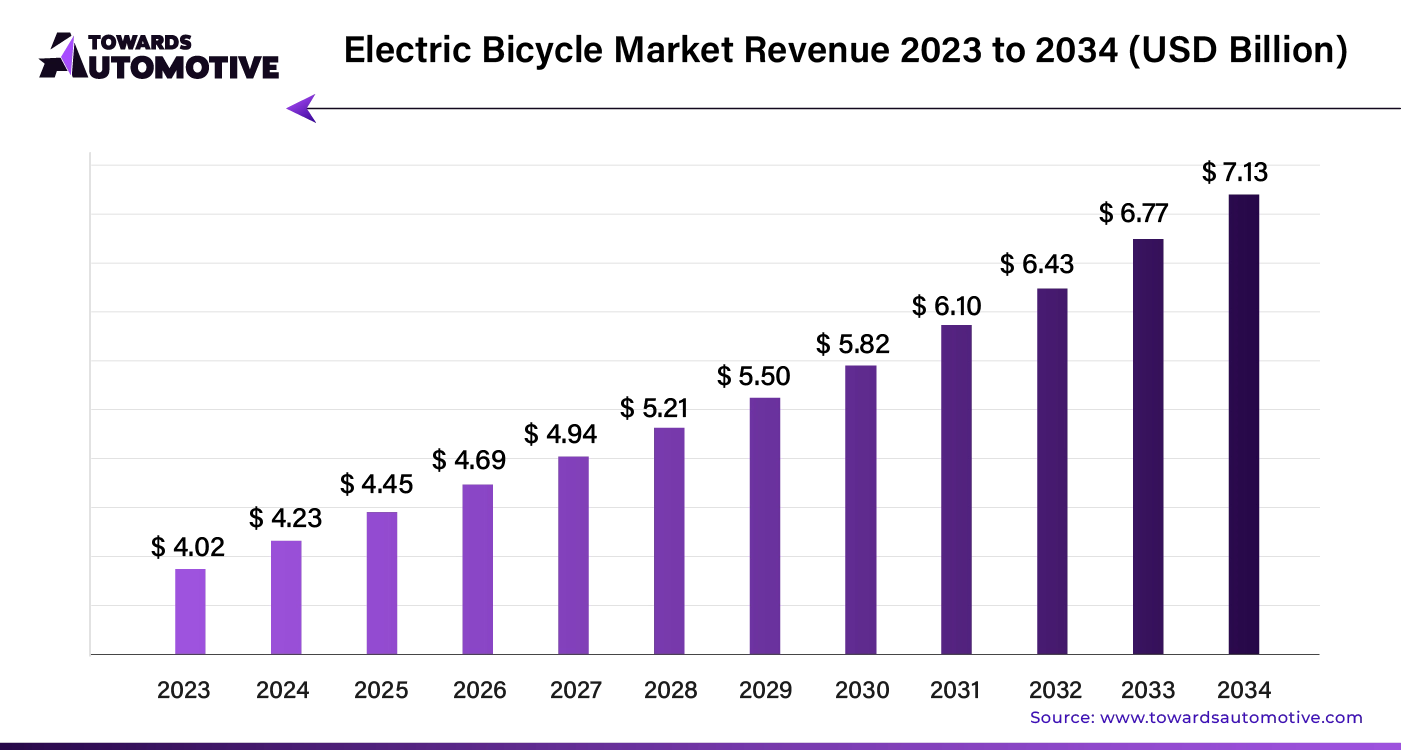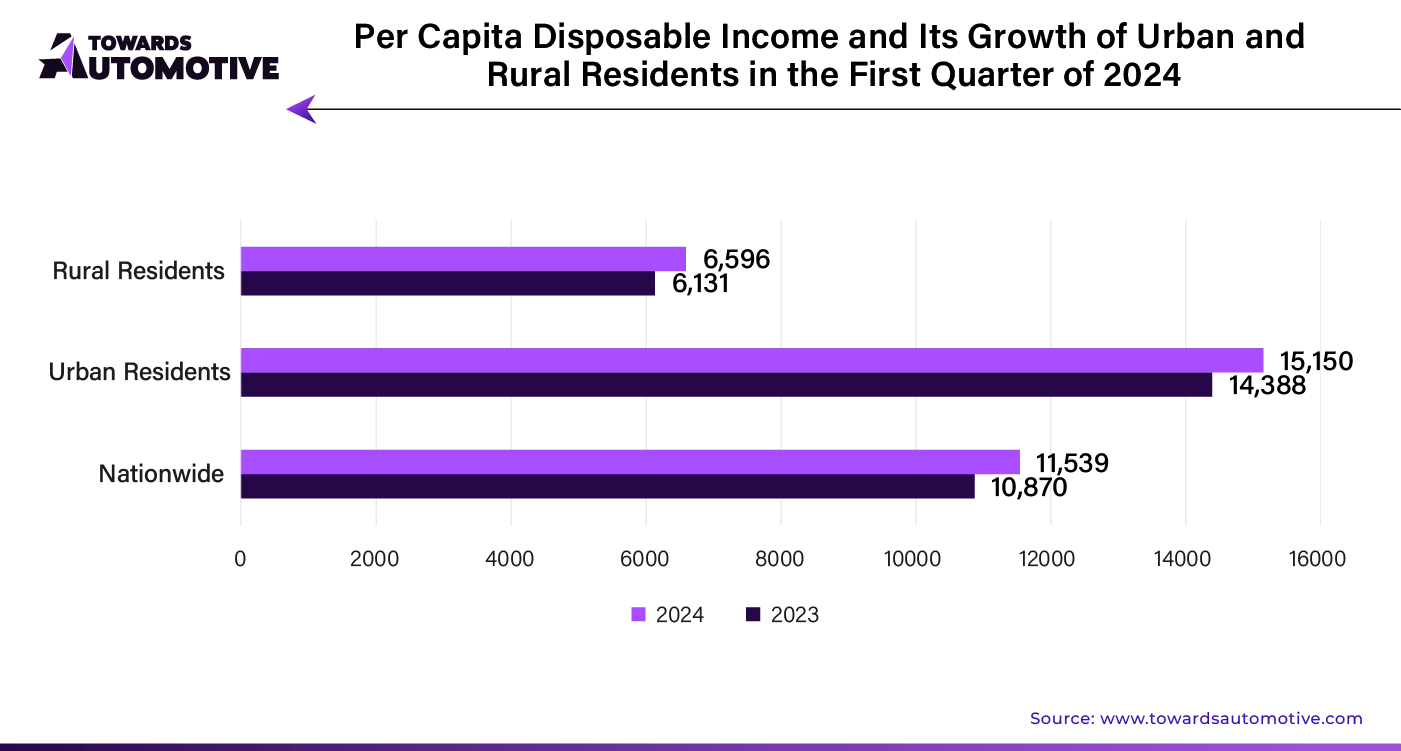April 2025
The electric bicycle market is forecast to grow from USD 4.45 billion in 2025 to USD 7.13 billion by 2034, driven by a CAGR of 5.3% from 2025 to 2034.

Unlock Infinite Advantages: Subscribe to Annual Membership
Electric bicycles are set to gain increased traction, driven by several key factors. Government initiatives and incentives are making e-bikes more accessible and affordable for consumers. These programs often include subsidies, tax credits, and infrastructure improvements, which are designed to encourage the adoption of eco-friendly transportation options.
As urban congestion becomes a growing concern, e-bicycles are emerging as a practical solution. They offer a convenient and efficient way to navigate through crowded city streets, providing a viable alternative to traditional cars and public transportation systems. This convenience, combined with the ability to bypass traffic jams, makes e-bikes an attractive option for daily commuting.
Rising awareness of the environmental benefits associated with eco-friendly transportation is also driving market growth. Consumers are increasingly seeking sustainable modes of transport to reduce their carbon footprint, and electric bicycles align with this growing trend toward greener living.
Moreover, continuous innovation and technological advancements are enhancing the performance and appeal of electric bicycles. Improvements in battery technology, motor efficiency, and overall design are extending the range and increasing the reliability of e-bikes. These advancements are making electric bicycles more attractive to a broader audience, further accelerating market expansion.
Factors Driving Growth in the Electric Bicycle Industry

For instance,

AI is set to transform the electric bicycle market by enhancing various aspects of the industry. By integrating AI technologies, electric bicycles can offer smarter, more efficient solutions tailored to individual needs. AI-driven systems will improve battery management through predictive analytics, optimizing energy use and extending battery life. Enhanced route planning algorithms powered by AI will enable cyclists to choose the most efficient and safe paths, taking into account real-time traffic and weather conditions.
Moreover, AI will boost user experience with personalized features such as adaptive cruise control and automated gear shifting, making rides more comfortable and enjoyable. Predictive maintenance powered by AI will help detect potential issues before they become serious problems, reducing downtime and maintenance costs. AI-powered data analysis will also provide valuable insights into consumer preferences and market trends, helping manufacturers innovate and stay ahead of the competition.
The supply chain in the electric bicycle market functions through a series of interconnected stages, ensuring that products reach consumers efficiently and cost-effectively. Initially, manufacturers source raw materials such as lithium-ion batteries, motors, and frame components from various suppliers. These components are then assembled into electric bicycles in factories. During assembly, quality control measures are strictly enforced to ensure high performance and safety standards.
Once assembled, electric bicycles are distributed through a network of wholesalers and retailers. Efficient logistics and transportation are crucial at this stage to minimize delays and costs. Retailers, including both physical stores and online platforms, then handle the final sales to consumers. To enhance customer satisfaction, after-sales services such as maintenance and support are also a key component of the supply chain.
Effective supply chain management in this market involves coordinating between suppliers, manufacturers, distributors, and retailers. Adopting advanced technologies like real-time tracking and data analytics can further streamline operations, reduce lead times, and respond quickly to market demands. By optimizing each link in the supply chain, businesses can improve their competitiveness and profitability in the growing electric bicycle market.
The electric bicycle market is driven by several key components and contributions from various companies. At its core, the ecosystem consists of electric motors, batteries, controllers, and frames. Electric motors, often provided by companies like Bosch and Shimano, are critical for providing the power necessary for propulsion. High-quality batteries from manufacturers like Panasonic and Samsung ensure long-lasting performance and efficient energy storage. Controllers, which regulate the flow of power between the motor and battery, are essential for smooth operation; companies such as Bafang and TranzX specialize in this area.
The frame, which supports the entire structure of the e-bike, is developed by companies like Trek and Giant, focusing on durability and lightweight materials. In addition, technology companies like Apple and Garmin are enhancing the e-bike experience with smart features and connectivity solutions. Companies like Rad Power Bikes and Ancheer are making e-bikes more accessible by offering direct-to-consumer models at competitive prices.
These components and companies work together to create a diverse and dynamic electric bicycle market, meeting the needs of a growing consumer base interested in sustainable and efficient transportation solutions.
United States: Sustainability Boosts Market Growth
The electric bicycle market in the United States is projected to grow at a compound annual growth rate (CAGR) of 5.3% through 2034. This growth is driven by heightened environmental awareness and concerns over climate change and air pollution. Electric bicycles, known for their zero-emission capabilities, attract eco-conscious consumers who seek alternatives to traditional cars and motorcycles.
As urban areas in the U.S. become increasingly congested and parking space becomes scarcer, electric bicycles offer a practical solution. They provide an efficient and convenient means of navigating through crowded city streets, reducing dependence on cars and public transit.
United Kingdom: Technological Innovations and Policy Support
In the United Kingdom, the electric bicycle market is expected to grow at a CAGR of 5.0% through 2034. This growth is supported by advancements in technology that have improved the performance, range, and affordability of electric bicycles, making them more accessible to a wider audience.
The UK government has introduced various policies and incentives to promote electric vehicles, including electric bicycles. These measures include subsidies, grants, and incentives for purchasing electric bikes, as well as investments in cycling infrastructure such as dedicated bike lanes and charging stations.
China: Evolving Mobility Preferences and Infrastructure Investments
China’s electric bicycle market is forecasted to expand at a CAGR of 5.2% from 2024 to 2034. This growth reflects a shift towards alternative transportation solutions as Chinese consumers increasingly embrace electric bicycles.
Improvements in cycling infrastructure, including the development of bike lanes, bike-sharing programs, and charging stations, enhance the safety and accessibility of cycling in Chinese cities. These investments support the growing popularity of electric bicycles as a practical and efficient mode of transport for short to medium distances.
Japan: Cultural Integration and Market Expansion
In Japan, the electric bicycle market is anticipated to grow at a CAGR of 5.4% through 2034. Japan’s strong cycling culture and well-developed cycling infrastructure create a favorable environment for the adoption of electric bicycles. They offer a convenient option for daily commuting, shopping, and recreational activities.
The increase in e-commerce and online shopping has driven demand for urban delivery services. Electric bicycles provide a cost-effective and environmentally friendly alternative for last-mile deliveries, aligning well with Japan’s transportation and delivery needs.
India: Addressing Traffic Congestion and Fuel Costs
The electric bicycle market in India is projected to grow at a CAGR of 5.2% through 2034. With major Indian cities experiencing significant traffic congestion, electric bicycles offer an efficient solution for navigating crowded roads and reducing travel time.
Fluctuations in fuel prices make electric bicycles an attractive alternative for short to medium-distance travel. They provide a cost-effective option for consumers looking to reduce their dependence on petrol and diesel vehicles, helping to mitigate the impact of rising fuel costs.
Li-Ion Batteries and Throttle Assist Technology Poised to Dominate the Electric Bicycle Market in 2024
The electric bicycle market is set for substantial growth, with lithium-ion (Li-Ion) batteries and throttle assist technology emerging as the leading trends in 2024.
Li-Ion Batteries: Leading the Charge
Li-Ion batteries are expected to secure a prominent share of approximately 42% in the electric bicycle market by 2024. Their advanced performance attributes are driving this dominance. Renowned for their efficiency and low self-discharge rates, Li-Ion batteries ensure that electric bicycles maintain reliable performance over time. This dependability enhances user experience by reducing the frequency of recharges and increasing the appeal of electric bicycles equipped with these batteries.
A notable advantage of Li-Ion batteries is their relatively fast charging times compared to alternative battery types. This feature allows users to quickly recharge their electric bicycles, making them more practical and convenient. The rapid charging capability supports more frequent use and extended trips, broadening the appeal of electric bicycles to a wider audience.
Throttle Assist Technology: A Market Leader
In terms of operation mode, throttle assist technology is projected to account for around 62% of the electric bicycle market in 2024. Throttle assist electric bicycles are popular for their ability to deliver immediate power, enabling riders to accelerate swiftly from a stop or navigate inclines with ease.
This quick response significantly enhances the riding experience, offering riders greater control and confidence, particularly in urban settings with frequent stops. Throttle assist bicycles are also designed for ease of use, making them accessible to a broad range of consumers, including those who may be unfamiliar with traditional pedal assist systems.
With throttle assist, riders can effortlessly engage the electric motor to provide additional propulsion. This functionality allows for smooth acceleration and speed maintenance with minimal effort, achieved through a simple twist of the throttle or press of a button. This user-friendly feature makes throttle assist bicycles an attractive choice for those seeking convenience and ease of operation.
The electric bicycle market is rapidly evolving, driven by technological advancements, shifting regulations, changing consumer preferences, and emerging market trends. Key players are continuously innovating to stay ahead in this competitive landscape.

As the electric bicycle market continues to expand, these key players are setting new standards and driving the industry forward with their innovative solutions and strategic developments.
By Class
By Battery Type
By Motor Type
By Mode
By Usage
By Region
April 2025
April 2025
April 2025
April 2025
We offer automotive expertise for market projections and customizable research, adaptable to diverse strategic approaches.
Contact Us